Physical Address
304 North Cardinal St.
Dorchester Center, MA 02124
Left ventricular ejection fraction (LVEF) plays a primary role in the diagnosis and management of cardiovascular disease. However, in many scenarios, a reduction in LVEF occurs at a late stage of disease, is often irreversible, and is associated with poor prognosis. Furthermore, LVEF as a measure of myocardial function has several limitations. First the two-dimensional (2D) measurement of LVEF relies on a shape assumption and can result in inaccurate quantification of LVEF, especially in the context of regional myocardial dysfunction. Although this shape assumption can be overcome by the use of three-dimensional (3D) echocardiography, this method is not feasible in up to ∼20% of the patients. LVEF is also an ejection phase index influenced by ventricular loading. The latter is particularly a problem for sequential follow-up of myocardial function in patients in whom loading conditions may change constantly (e.g., those receiving cancer therapies). LVEF measurements are also influenced by LV geometry and can be limited in the assessment of myocardial function in patients with LV hypertrophy. Finally LVEF measurements are subject to temporal and interobserver variability, which can be as high as 10% for 2D LVEF and 6% for 3D LVEF. , As a consequence of these challenges, LVEF has limitations as a marker of myocardial function for the recognition of subclinical heart failure (HF).
To overcome some of the limitations of LVEF measured by echocardiography, myocardial strain has emerged as a robust measure of subclinical HF. Strain measurements, especially peak systolic global longitudinal strain (GLS), allows detection of prognostically important myocardial dysfunction even when LVEF is normal. This is driven by several factors, including the fact that strain measures myocardial deformation as opposed to endocardial translation; global measurements are obtained as an average of multiple views; and strain measurement, particularly GLS, has good intraobserver, interobserver, and test-retest variability. Although strain measurements are certainly subject to image quality, they may be less affected by degradation in 2D image quality when compared with 2D LVEF and likely 3D LVEF. Therefore, especially in diseases that diffusely affect the myocardium, myocardial strain may be a more robust measure of subclinical HF than LVEF.
Patients with HF risk factors (e.g., diabetes, hypertension, receiving potentially cardiotoxic cancer therapy) are considered to be in stage A HF in the absence of structural or functional myocardial abnormalities. Patients can then progress to develop asymptomatic myocardial damage manifested by reduction in LVEF, ventricular dilation, or LV hypertrophy. These patients are considered to be in stage B HF and are at a high risk of progressing to symptomatic HF (stage C and D), which is associated with worse prognosis ( Central Illustration ). However, relying on these traditional measures may be inadequate to detect myocardial dysfunction at a stage when complete recovery is feasible with interventions. Strain can be used to identify patients in transition from stage A to stage B HF and may provide an opportunity to initiate HF therapy and aggressive control of the underlying risk factors to prevent subsequent progression symptomatic HF. In many scenarios such as hypertension, diabetes, and patients receiving cancer therapy, strain abnormality has been demonstrated as the first measure of impact of the underlying disease on the myocardium (see Central Illustration 2.1). The development of a strain abnormality is prognostically important in these patients, and in the context of hypertension, diabetes, or obesity, it is associated with lower cardiopulmonary fitness similar to that seen with other markers of stage B HF. ,
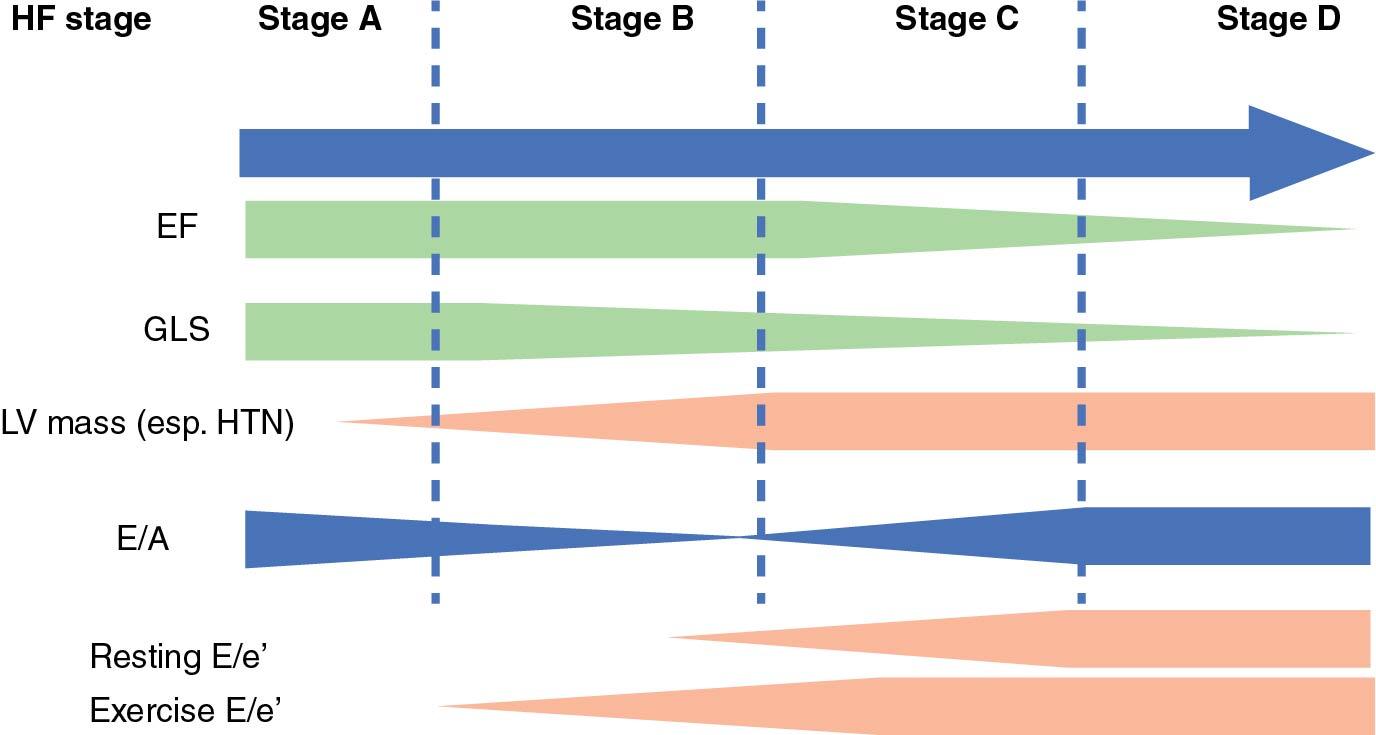
The field of cardio-oncology has grown tremendously since its introduction in the late 1990s. This is being driven by the increasing incidence of cancer globally, a remarkable improvement in survivorship, and a growing interest in the overall health of cancer survivors. In the United States alone, there are over 15.5 million cancer survivors, a number that is expected to increase to 20.3 million by 2026 ( www.cancer.gov ). Cancer survivors are at a risk of a multitude of health issues, with cardiovascular disease (CVD) being a major contributor to morbidity and mortality. This is due to shared risk factors for cancer and CVD, the direct impact of cancer on the cardiovascular system, the on- and off-target effect of cancer therapy on the cardiovascular system, and a potential gap in the cardiovascular care of cancer survivors ( Fig. 2.1 ). In pediatric and older adult cancer survivors, for example, CVD is the primary competing risk of mortality. ,
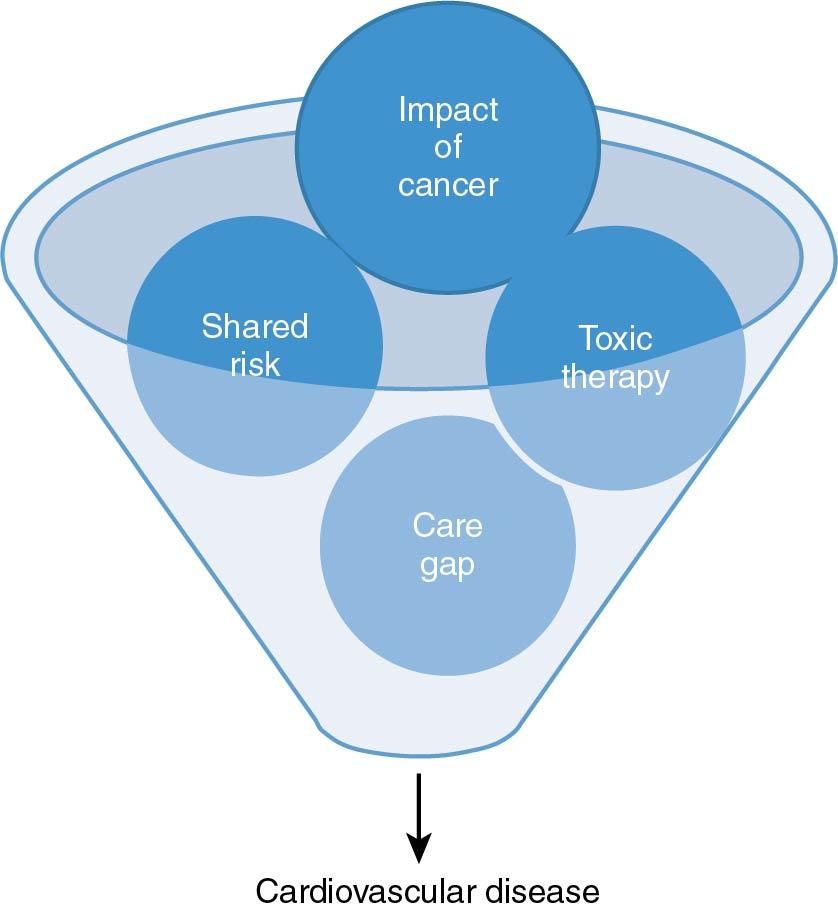
CVD, cardiomyopathy, and HF have been a major focus in the field of cardio-oncology for several reasons. HF is the primary manifestation of some of the most common cancer therapies used in the field of cardio-oncology (e.g., anthracycline, trastuzumab). , It commonly occurs during cancer treatment, impacting completion of cancer therapy. It is more readily recognized by widely available noninvasive imaging techniques such as echocardiography, multigated acquisition (MUGA) scan, and cardiovascular magnetic resonance (CMR) imaging. Finally, the development of HF in patients with cancer is associated with poor prognosis.
The primary interest in HF with cancer therapy was driven by anthracyclines. The risk of HF with anthracyclines is known to be dose dependent, with the incidence reaching 48% with doses exceeding 750 mg/m 2 . This recognition was followed by attempts to detect “early” myocardial dysfunction before the development of clinical HF with the hope of mitigating risk by stopping anthracycline therapy and instituting cardiac medications. The first systematic demonstration of this approach was in 1987 based on 7-year experience of following patients receiving doxorubicin-based therapy using repeated MUGA scans. The occurrence of a 10% absolute reduction in LVEF to <50% was shown to precede the administration of the final dose of doxorubicin that precipitated clinical HF. The cessation of doxorubicin therapy and administration of cardiac medications (digitalis, diuretics, and/or vasodilators) in the patients who met this threshold criterion resulted in a 17.9% absolute reduction in progression to HF. Most important, this approach worked both in academic and community settings. This heralded an era of cardiac monitoring with repeated measurement of LVEF during cancer therapy as a common practice within the oncology community—sometimes extending beyond anthracycline therapy. The emphasis on repeated cardiac monitoring was further propelled by the introduction of trastuzumab therapy for women with human epidermal growth factor receptor 2–positive (HER2+) breast cancers in the late 1990s. Based on procedures in the original clinical trials, monitoring of LVEF using cardiac imaging every 3 to 6 months during trastuzumab therapy has become a common practice. The use of imaging led to an unusual situation whereby the change in EF defined the diagnosis of cardiotoxicity, to which additional uncertainty was added by variations between diagnostic criteria ( Table 2.1 ), as well as confusion because the development of HF in later years is truly the target we seek to avoid, with change of EF only being a surrogate. Indeed, there is an arbitrariness in the current criteria—some use an EF cutpoint of 50%, others 53% and others 55%—whereas actual normal ranges vary by age, gender, race ( Fig. 2.2 ), and imaging modality. The EF changes are driven more by custom than the reproducibility of the parameter—with 2D-EF, the confidence intervals are about 12%; with 3D-EF, they are about 6% , ; and with CMR-EF, they are less still. The rationale for the symptomatic versus asymptomatic distinction is not based strongly on evidence—one might take the position that a patient with new HF symptoms has cardiotoxicity irrespective of EF change—these patients may, after all, develop HF with preserved EF (HFpEF). Indeed, perhaps as a reflection of these limitations, imaging surveillance for cardiotoxicity is honored in the breach. In a recent data linkage of Truven MarketScan data of 16,456 patients undergoing chemotherapy for breast cancer between 2009 and 2014, the adherence to LVEF monitoring (at baseline and every 4 months) in 4325 patients taking trastuzumab was 46% (as low as 40% in patients <35 years old) ( Fig. 2.3 ). Nonetheless, this was not a low-risk group—the rate of congestive HF (defined by one inpatient claim or two outpatient claims 30 days apart) was 4.2% overall (8.3% in trastuzumab therapy and 2.7% in other therapies).
| Standard | Definition of Cardiotoxicity | Clinical and Imaging Features |
|---|---|---|
| American Society of Echocardiography and European Association of Cardiovascular Imaging (ASE/EACVI) | LVEF fall by >10% to absolute EF <53% | May be global or regional change in LV function Symptomatic or asymptomatic for HF |
| European Society of Cardiology (ESC) | LVEF fall by >10% from baseline to EF <50% | Symptomatic or asymptomatic for HF |
| National Cancer Institute (NCI) | HF grade 1–5 adopted in common terminology criteria for adverse events | Grade 1 (asymptomatic) Grade 2 (mild to moderate symptoms) Grade 3 (symptomatic on minimal exertion or at rest) Grade 4 (life threatening) Grade 5 (death) |
| Canadian Cardiovascular Society (CCS) | LVEF fall by >10% from baseline or LVEF <53% | Guidelines also recommend (1) 3D echocardiography or same imaging modality during cancer therapy, (2) myocardial strain imaging, and (3) cardiac biomarkers (N-terminal pro brain natriuretic peptide, troponin) for early detection |
| European Society of Medical Oncology (ESMO) | Symptomatic decline in LVEF of at least 5% to <55% or asymptomatic decline in LVEF of at least 10% to <55% | Symptoms for congestive HF with signs including but not limited to S3 gallop, tachycardia, or both Decline in LVEF either global or regional |
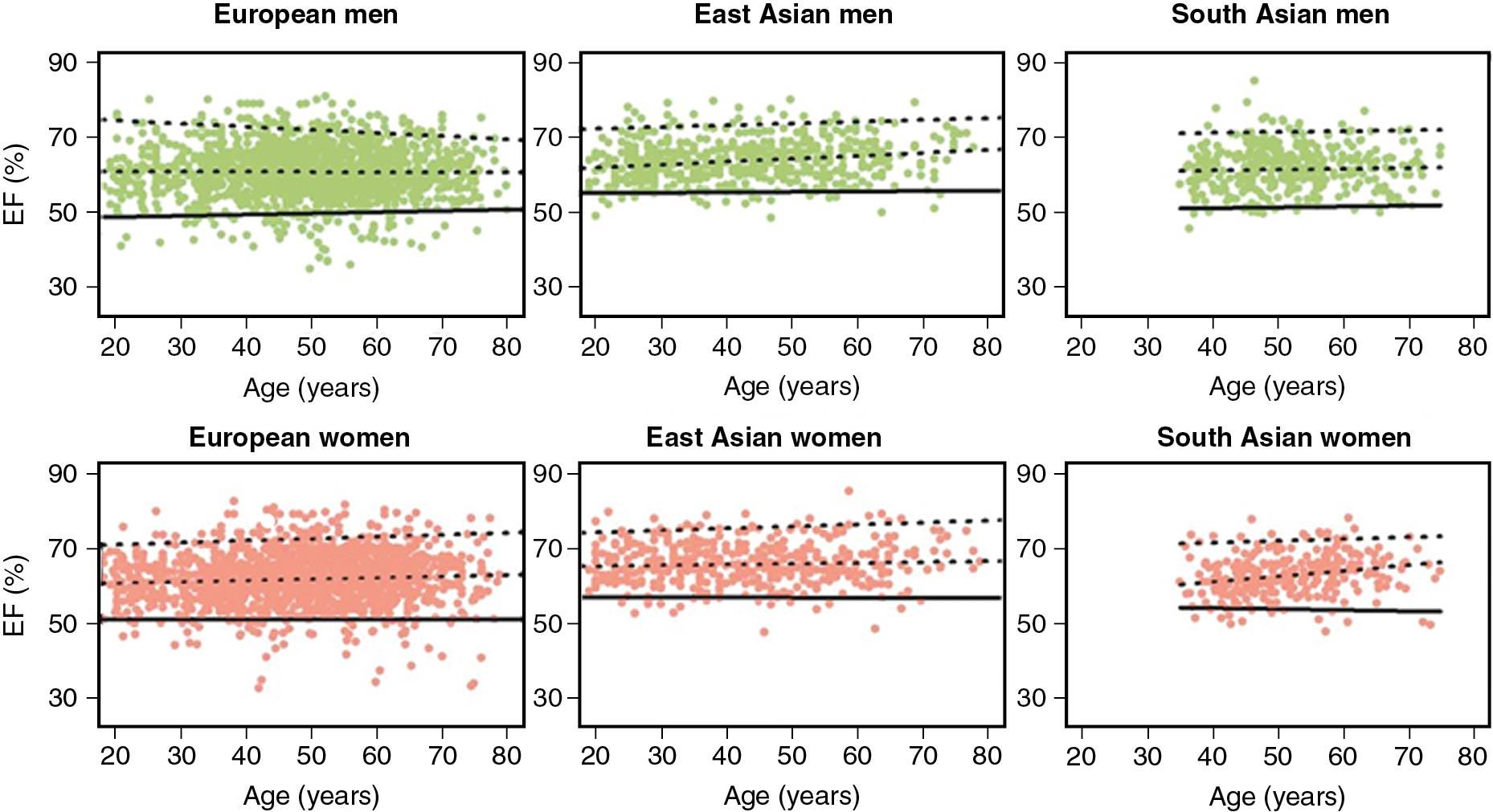
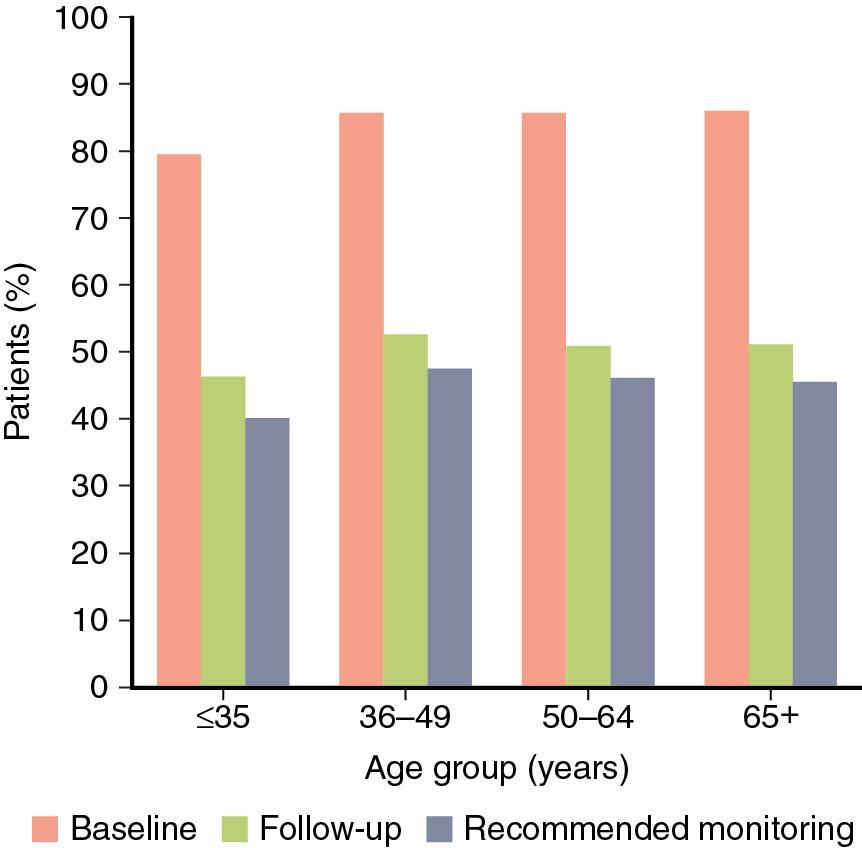
Over decades of using LVEF to monitor for cancer therapeutics–related cardiac dysfunction (CTRCD) from cancer therapy, it is now evident that a reduction in LVEF may identify a relatively late stage of myocardial injury with certain cancer therapies. With anthracyclines, for example, after LVEF drops, despite contemporary HF therapy, complete recovery to pretreatment LVEF occurs only in 11% of patients. The lack of LVEF recovery is associated with the future development of major adverse cardiovascular events (MACEs). With other therapies such as trastuzumab, improvement in LVEF with HF therapy is more common; however, values tend to still remain below precancer therapy values even in long-term follow-up. Therefore, earlier markers of myocardial injury that predate a significant reduction in LVEF may help identify patients at a stage where targeted interventions may reduce the risk of cardiotoxicity and subsequent clinical HF.
Echocardiographic markers, other than myocardial strain, that have been considered for the early detection of myocardial injury during cancer therapy can be broadly categorized into those assessing systolic and diastolic function. Measures of systolic function include tissue Doppler measured s′ velocity and mitral annular systolic excursion measured by M-mode echocardiography. , In patients receiving trastuzumab-based therapy for breast cancer, a reduction in mitral annular s′ velocity early during trastuzumab therapy may identify patients who subsequently develop CTRCD. , Similarly, reductions in mitral annular systolic excursion can occur early during anthracycline therapy, although the prognostic value of this finding is not established.
The temporal relationship between diastolic function measures and subsequent CTRCD has been inconsistent among published studies. Among prognostic studies, reduction in diastolic function indices, including E velocity, E/A ratio, and e′ velocity, have been shown to be associated with subsequent anthracycline-induced CTRCD. , Changes in diastolic parameters such as E/A ratio seem to occur as early as after the first dose of anthracycline therapy in children with hematologic malignancies. In a recently published longitudinal cohort study of 362 patients with breast cancer, Upshaw and colleagues documented a persistent worsening in diastolic function (reductions in the E/A ratio, lateral and septal e′ velocities) with doxorubicin (blue) and doxorubicin with trastuzumab (purple) but not trastuzumab alone (green) over a median follow-up period of 2.1 years ( Fig. 2.4 ). Abnormal and worsening diastolic dysfunction was associated with a small risk of subsequent systolic dysfunction—both LVEF ( P <.001) and GLS ( P =.013). Worsening of diastolic function grade compared with baseline portended a twofold higher risk of developing CTRCD on the subsequent echocardiogram. These data support the American Society of Echocardiography (ASE) expert consensus position that supports comprehensive assessment of cardiac function (including both systolic and diastolic parameters) in patients receiving cancer therapy.
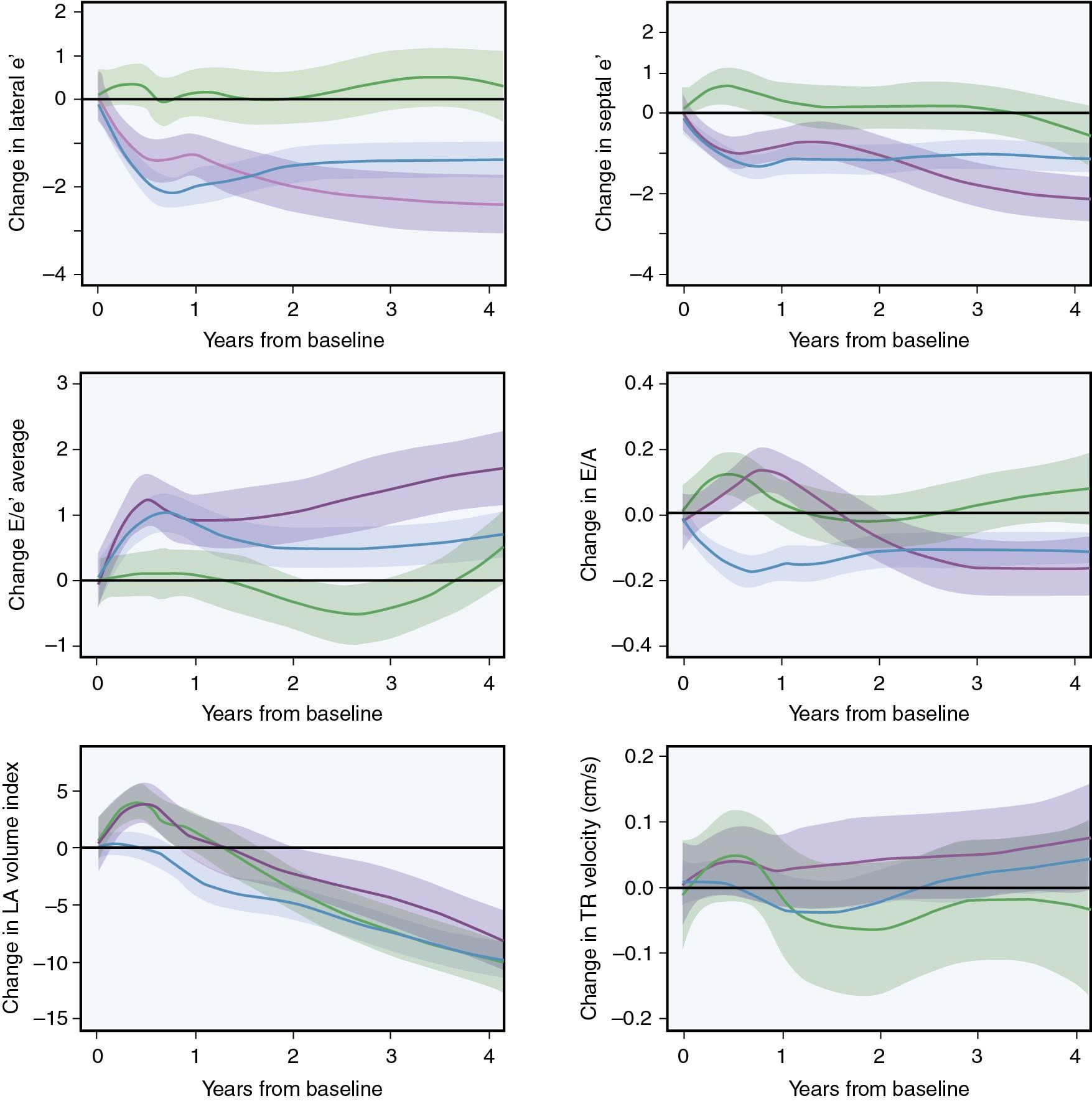
Assessment of risk for HF prior to initiation of cancer therapy is challenging. Individual patient-specific risk factors such as diabetes, hypertension, and age, as well as treatment-related factors such as dose of therapies (e.g., anthracyclines, trastuzumab, and radiation therapy) may help identify risk. Risk models that incorporate these risk factors are limited and lack appropriate discrimination and validation. , However, many of the patient-related risk factors likely culminate in subclinical myocardial dysfunction that is not discovered by clinical history or traditional assessment of LVEF or diastolic parameters. Myocardial strain may play a role in identifying patients who have a vulnerable myocardium, hence providing an opportunity to institute primary preventive strategies to mitigate the risk of CTRCD and clinical HF.
| Study | Endpoint | Univariate AUC | Unadjusted OR/HR (95% CI) | Adjusted OR/HR (95% CI) | Covariates (if adjusted models) |
|---|---|---|---|---|---|
| Absolute on-treatment GLS | CTRCD | 0.67–0.95 | HR 2.77, OR 1.75 | HR 4.10, OR 1.33–1.71 | Renal failure, BB use, trastuzumab therapy, age, ANT dose, posttreatment GLS LAVi, LVEF, LVEDVI |
| Relative (%) change in GLS | CTRCD | 0.74–0.97 | OR 1.01–1.65 | 1.11 (1.03–1.19) | Age, HTN, DM, HLD, smoking, LVEF |
| Delta (absolute) change in GLS | CTRCD | 0.61–0.84 | OR 0.94–3.98 | OR 0.94–1.25 | Age, sex, race, heart rate, DM, HTN, HLD, ACEi/ARB/BB use, regimen, echo timepoint |
| Pretreatment GLS | MACE | 0.89 (0.84–0.95) | HR 1.36–1.47 | HR 1.36 | DM, LVEF, age, cancer type |
| CTRCD | - | - | OR 1.09 (0.86–1.38) | BB use, trastuzumab therapy, age, ANT dose, posttreatment GLS |
The literature on the use of strain to identify pretreatment risk of CTRCD or development of major adverse cardiovascular “cardiovascular events has focused on patients receiving anthracycline based therapy. Both peak systolic . . . ” peak systolic GLS and global circumferential strain (GCS) based on mid short-axis slices may identify patients at risk of CTRCD, although the findings have not been uniform among studies ( Fig. 2.5 ). A GLS threshold of −19.95% prior to initiation of anthracycline-based therapy has been associated with the development of CTRCD in patients with hematologic malignancy after receiving a 150-mg/m 2 cumulative dose of doxorubicin. Further supporting this finding, others have demonstrated that every 1% absolute reduction of baseline GLS was associated with an odds ratio (OR) of 1.48 for the development of CTRCD. Similarly, a GLS measurement threshold of −17.5% (three apical views, Tomtec software) in anthracycline-treated patients with hematologic malignancy was associated with a sixfold increase in the risk of cardiac death or symptomatic HF. However, these thresholds have been inconsistent, with a more recent study in patients with lymphoma receiving anthracycline suggesting −19% as the threshold associated with subsequent risk of CTRCD posttreatment and long-term risk of HF hospitalization. GLS had incremental value over clinical variables and baseline LVEF. A potential practical application of GLS in patients receiving anthracycline-based therapy may be in individuals in whom the baseline LVEF is in the “low normal range (50–59%)”; GLS measurements may further risk stratify patients into low and high risk for subsequent MACE. Similarly GCS at baseline may help identify patients at risk of CTRCD, with every 1% lower GCS (measured based on a mid short-axis image) being associated with a 23% to 31% increased odds of CTRCD. However, other studies have shown no association between GLS , and GCS at baseline and the subsequent development of CTRCD after multivariable adjustment.
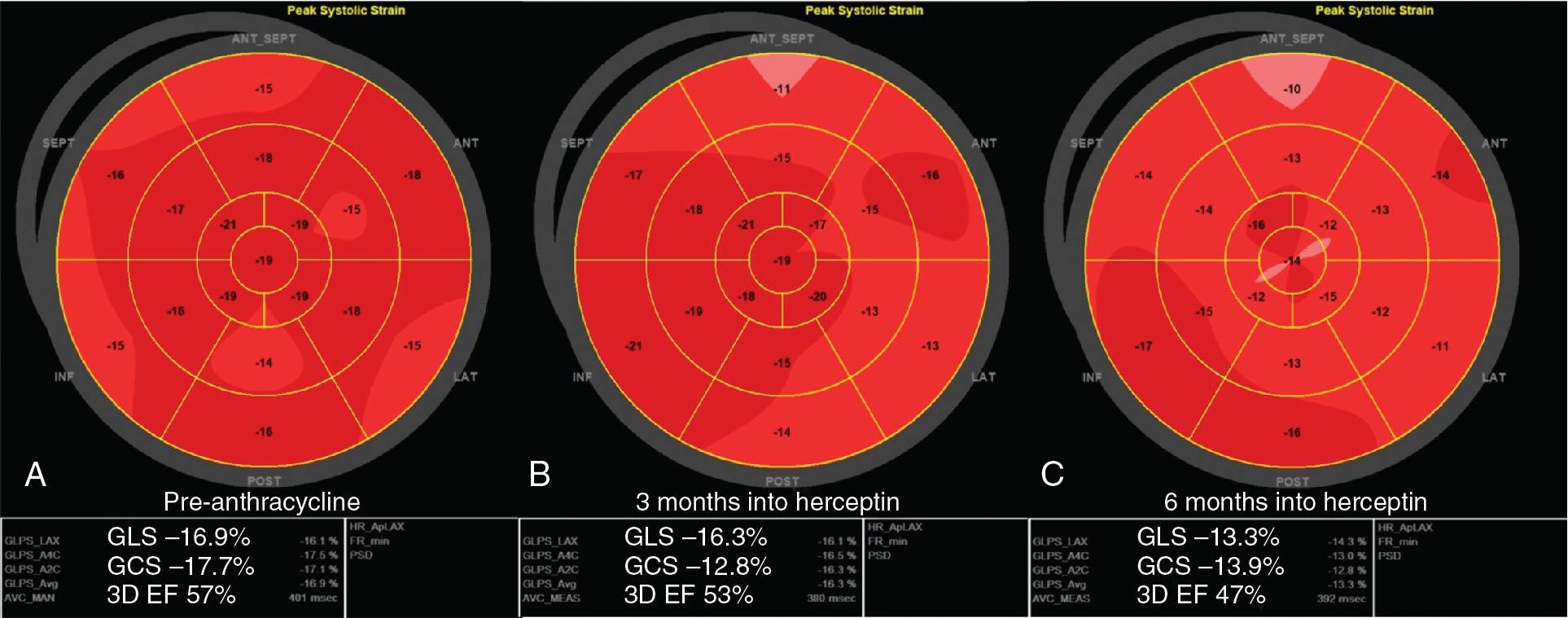
Although the link between lower baseline measurement of myocardial strain and the development of CTRCD or cardiovascular events does have biologic plausibility, existing data are inadequate to support its routine use in clinical practice. This is likely explained by the fact that the development of CTRCD is a multifactorial process that is not merely dependent on the status of the myocardium prior to cancer therapy.
Because robust imaging methods and HF risk prediction algorithms are unavailable to identify patients at risk of HF prior to cancer therapy, there is a greater focus on detection of subclinical LV dysfunction at an early stage. Given that the development of traditional stage B HF (i.e., reduction in LVEF) results in unnecessary interruption to cancer therapy, the interest has been on measures that detect myocardial changes at the transition from stage A to B HF. The primary candidates for this role are blood biomarkers, cardiac magnetic resonance imaging measures of function and myocardial relaxometry, and echocardiography-based myocardial strain. Despite the enthusiasm about other measures, the most relevant method that is close to clinical application is echocardiographic measurement of myocardial strain.
Some of the earliest studies that examined the utility of strain to detect subclinical myocardial dysfunction during cancer therapy now date back over a decade. All of these studies focused on adult and pediatric patients with hematologic and breast malignancies receiving anthracycline-based therapy. There is heterogeneity among studies with respect to age of the patients, cancer types, and timing and duration of follow-up. Some of the early studies utilized tissue Doppler imaging (TDI)–based strain with the more recent studies using 2D speckle-tracking echocardiography (STE). The TDI strain studies demonstrated regional variability in changes in myocardial function during anthracycline therapy. , Longitudinal strain rate (SR) changes particularly involving the basal interventricular septum early during anthracycline therapy is the most consistent finding. These changes were seen as early as after the first dose of anthracycline. The degree of longitudinal SR change between pretreatment and early during anthracycline therapy varied from 9% to 20%. Interestingly, segmental longitudinal strain (as opposed to strain rate) with TDI was not a reliable measure of early myocardial injury in these studies, likely demonstrating the fact that the major strength of longitudinal strain measurement is in the ability to average information from multiple myocardial segments. In support of this hypothesis, studies that examined TDI-based longitudinal strain from multiple myocardial segments did demonstrate 15% to 17% reduction early after initiation of anthracyclines. Regional changes in radial strain and strain rate have also been shown to identify early myocardial injury in the context of anthracycline therapy; however, the findings have been inconsistent among studies. , ,
Similar to TDI strain, studies using STE have also consistently suggested reductions in peak systolic GLS either during (e.g., within 1 week of starting anthracyclines) or soon after completion of anthracycline therapy for various cancers in the absence of significant reduction in LVEF. The degree of reduction has ranged from 9% to 19% among published studies. An important new knowledge generated through these studies was the fact that even doxorubicin doses <200 mg/m 2 are associated with myocardial deformation changes. Reduction in both peak systolic global radial strain (GRS) and/or GCS ranging from 6% to 19% also occurs early during anthracycline therapy. , However, these measures are not readily available for routine application. Also, the reproducibility of GCS and GRS may not be as robust as that of GLS. 2D STE-based strain rate and rotational mechanics have also been studied to detect early myocardial injury, but these measures are predominantly limited to the research setting.
Myocardial strain may also have value in the detection of myocardial injury from radiation therapy, although existing studies have been inconsistent. In the context of therapy for breast cancer compared with pretreatment, an approximately 9% to 10% relative reduction in GLS and 11% to 13% reduction in GLS rate have been reported either during or immediately after radiation therapy with mean heart doses of 2.5 to 9.0 Gy. , The biologic plausibility of this finding was buttressed by the fact that strain reduction was seen in those with left-sided but not right-sided breast cancer. The largest reduction in strain was seen in the myocardial segments that received the greatest radiation dose. This dose responsiveness has also been demonstrated in other patient cohorts with greater reduction in longitudinal systolic and/or diastolic strain with greater doses of radiation therapy to the thorax. Other studies in patients with left-sided breast cancer have also confirmed reduction in GLS posttherapy in the short and long terms and the regionality of the changes corresponding to radiation fields. , The impact of radiotherapy is likely additive to that of chemotherapy. In long-term cancer survivors of Hodgkin lymphoma, a greater reduction in GLS has been reported in those who received combined therapy with anthracyclines and radiation compared with those who received radiation therapy alone (21% vs 14%). The relationship between radiation therapy and strain has, however, not been consistent, with studies either not identifying direct impact of radiotherapy or unable to demonstrate the added impact of radiotherapy beyond that of chemotherapy. , , Some of this variability may relate to improvement in radiation therapy delivery techniques.
Other methods to detect early myocardial changes during cancer therapy have included 3D strain and right ventricular (RV) strain. The data on the use of 3D strain to detect early myocardial dysfunction are quite limited; however, existing studies suggest that the nadir of 3D GLS during treatment with anthracyclines and trastuzumab occurs earlier than 2D GLS. Despite the enthusiasm for 3D strain, its feasibility in patients receiving cancer therapy has been shown to be significantly lower than the respective 2D strain measurements. Changes in RV strain may also illustrate early myocardial injury during anthracycline therapy , ; however, its diagnostic value is unclear because of the limited number of published studies focused on RV strain.
Regardless of the patient cohort and the strain method studied, most of the existing literature suggests that changes in LV strain occur prior to a significant reduction in LVEF during cancer therapy.
The understanding that myocardial strain can identify subclinical cardiomyopathy at low anthracycline doses and before a significant reduction in LVEF resulted in investigations that examined whether these early reductions during treatment can identify patients at subsequent risk of significant LVEF reduction (i.e., CTRCD) or HF. The premise for this approach is the fact that early detection of myocardial injury may provide a window of opportunity to initiate cardiac medications to prevent subsequent CTRCD, HF, and interruption of cancer therapy. The importance of such an approach is also strengthened by the fact that when a fall in LVEF occurs with some therapies such as anthracyclines, complete recovery only occurs in a minority of patients. ,
Currently, there are over 21 studies consisting of >2000 patients that have directly examined the prognostic value of GLS to identify subsequent risk of CTRCD during cancer treatment. The cancer types, treatment regimens, age spectrum, frequency of follow-up, definition of CTRCD, and echocardiography systems used to measure strain have all varied among published studies. As demonstrated in a recent meta-analysis, these differences contribute to significant heterogeneity among these published studies. Regardless, existing studies suggest there are three different approaches to using strain for prognostication during cancer therapy. The first is to examine an absolute strain value during treatment (e.g., GLS of −19% at 3 months into treatment), second is an absolute change during treatment compared with baseline (e.g., an absolute 2% change in GLS), and third is a relative change during treatment compared with baseline (e.g., a 15% relative reduction in GLS). The latter approach is the primary method endorsed in the ASE Expert Consensus Document with the use of absolute strain value during treatment in scenarios when a baseline measure in unavailable. The reason for endorsing a relative change is the fact that this approach accounts for known baseline differences in GLS between individuals and the potential for this measure to be vendor independent.
The studies that have examined the prognostic value of an absolute GLS measurement during treatment have uniformly demonstrated its utility with patients having lower values being at higher risk of CTRCD. Based primarily on the General Electric (GE) system measured GLS, the threshold GLS value during treatment with anthracyclines and/or trastuzumab therapy that identifies risk of CTRCD ranges from −13.8% to −21.0%. The median threshold value among the studies based on a recent meta-analysis was −18.0% with a median sensitivity and specificity of 86% and 73%, respectively. Also the reported summary OR for subsequent CTRCD for patients with worse GLS during treatment compared to better GLS was 12.27 (95% confidence interval [CI], 7.73–19.57). Therefore, although it has not been common practice to use an absolute GLS value during treatment to identify patients at risk of CTRCD, this may be a viable approach ( Fig. 2.6 , clinical example). This approach is particularly attractive in patients in whom a baseline strain was either not measured or a different imaging modality was used.
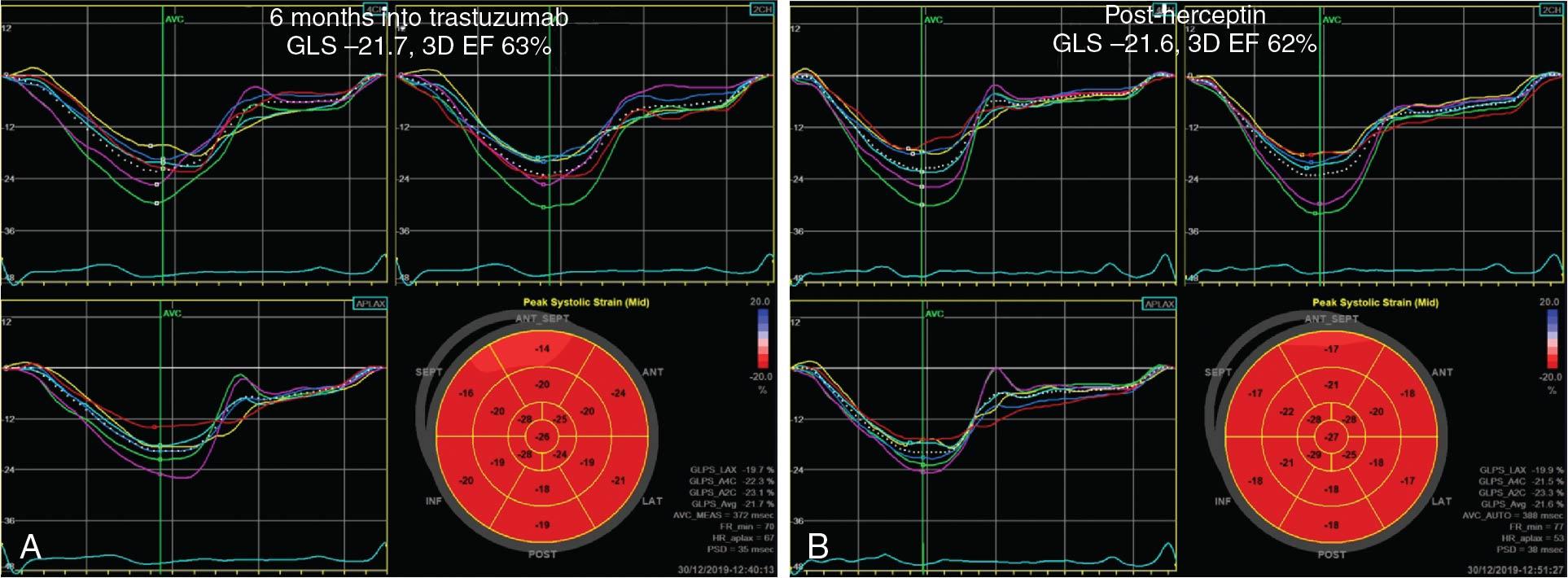
An alternate approach is to consider an absolute change in strain during treatment in comparison with baseline. Existing studies have reported threshold changes in GLS ranging from 0.45% to 2.77% as a prognostic marker with sensitivity ranging from 80% to 83% and specificity 65% to 81%. , , However, it is unclear whether such small absolute changes in GLS can be reliably identified within the known temporal and observer variability in strain. Furthermore, other studies have suggested no association between absolute changes in GLS and subsequent risk of CTRCD, especially in adjusted analyses. , , A potentially interesting approach that has not been considered in the literature is to use an absolute change in GLS to a value below a threshold level (e.g., −18.0% with GE-based GLS) analogous to the definitions of CTRCD based on LVEF. Similar to GLS, there is also an association between early absolute changes in GCS and subsequent reduction in LVEF or CTRCD. , In women with breast cancer receiving anthracyclines with or without trastuzumab therapy, each one interquartile range change in GCS at 4 to 6 months into treatment was associated with a ∼2% reduction in LVEF at 1-year follow-up.
The method endorsed by the ASE for surveillance during cancer therapy is to use a relative change in GLS of >15% to identify prognostically important subclinical cardiomyopathy ( Fig. 2.7 , clinical example). This is calculated as a difference between on- and pretreatment measurements, as a ratio of the pretreatment measurement. The prognostic thresholds in published studies have ranged from 2.3% to 15.9% relative change occurring during 2 to 6 months during treatment with a median of 13.7% and sensitivity and specificity of 86% and 79%, respectively, based on a recent meta-analysis. The summary OR high versus low GLS (i.e., a significant change vs not) based on published studies has been reported at 15.8 (95% CI, 5.8–42.9), although there is significant heterogeneity between studies.
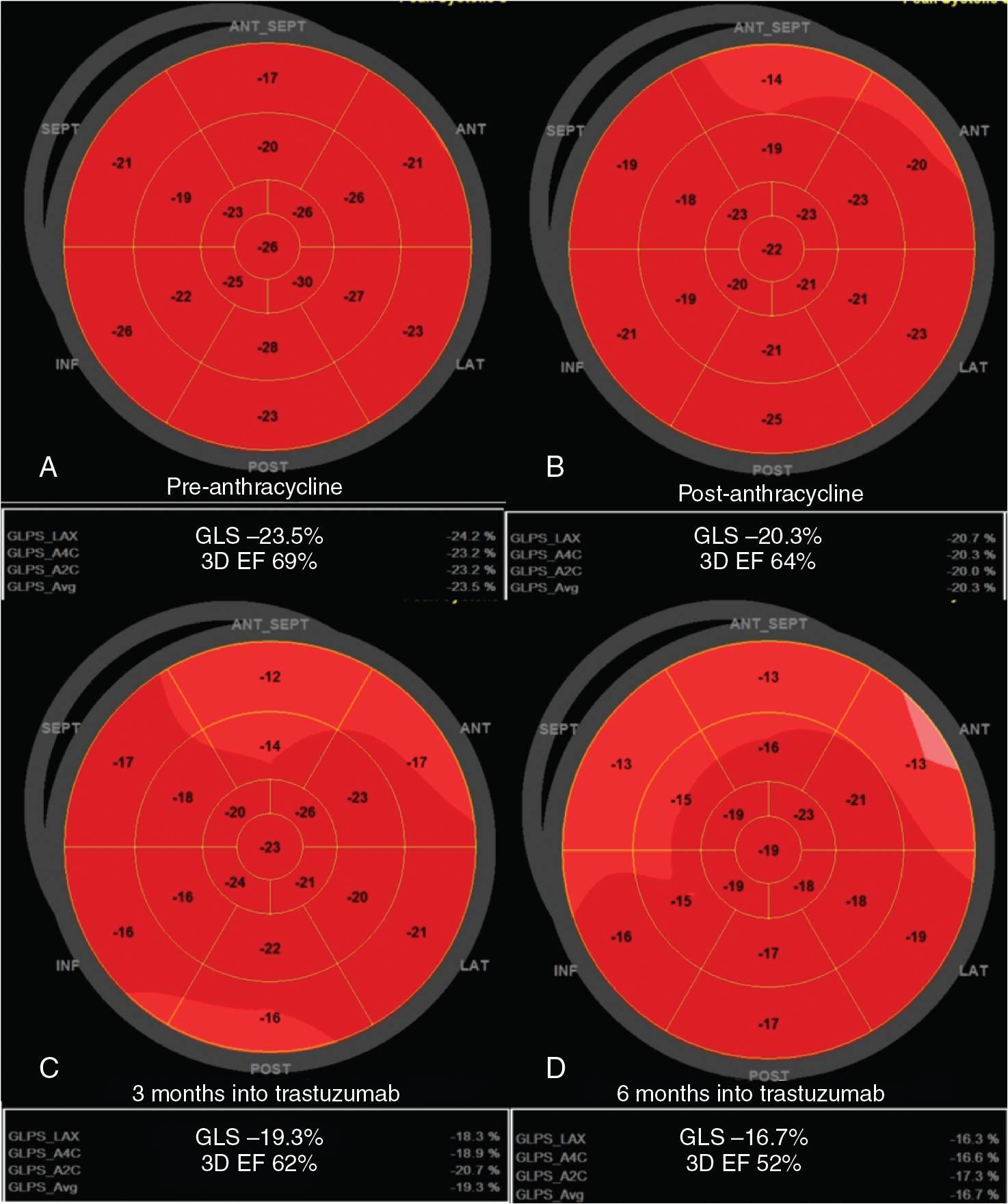
Another prognostic application of myocardial strain is to determine the chance of recovery of myocardial function or subsequent MACE in patients with CTRCD. In women with HER2+ breast cancer receiving anthracyclines followed by trastuzumab, lower GLS values at the time of CTRCD were associated with low propensity toward recovery of LVEF, with patients whose GLS was <15.8% at nadir having a hazard ratio (HR) of 0.39 (95% CI, 0.19–0.74) for subsequent recovery. Outside of the setting of use of anthracycline and trastuzumab, GLS may have prognostic value in patients with immune checkpoint inhibitor–induced myocarditis. Approximately 50% of patients with acute myocarditis have preserved LVEF ; however, GLS values have been shown to be lower in these patients compared both with baseline and with patients without myocarditis ( Fig. 2.8 ). Lower GLS values in patients with and without preserved LVEF are associated with subsequent risk of MACE (HR 1.4–4.4).
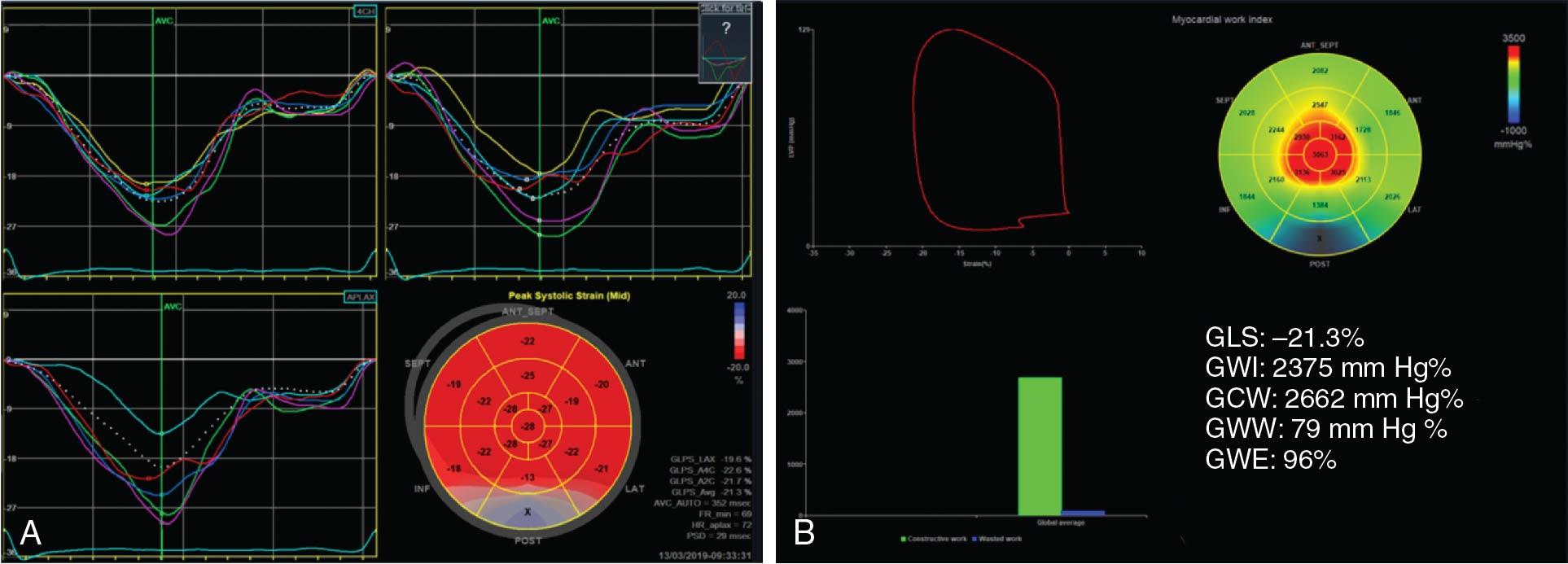
It is important to note that for the prognostic studies, the techniques for strain measurements have been variable among studies. Several studies have used only two apical views with inclusion of basal and midmyocardial segments for the calculation of strain (i.e., excluded apical segments), but others have used all three views. There has also been some consideration of using single-view strain measurements (i.e., only four-, three-, or two-chamber apical views) to follow patients during cancer therapy. Despite the fact that such single-view use may enhance routine clinical use through point-of-care applications, such an approach will result in misclassification of up to ∼20% of patients compared with GLS calculated from all three views. Therefore, whenever possible, the use of all three apical views should be considered.
Important limitations in the literature on the prognostic value of strain measurements for subsequent CTRCD have included the limited demonstration of whether GLS or GCS truly has incremental value over clinical parameters and other traditional echocardiographic measures for the diagnosis of CTRCD and the lack of well-powered studies to demonstrate association with clinical HF or cardiovascular mortality. ,
Become a Clinical Tree membership for Full access and enjoy Unlimited articles
If you are a member. Log in here